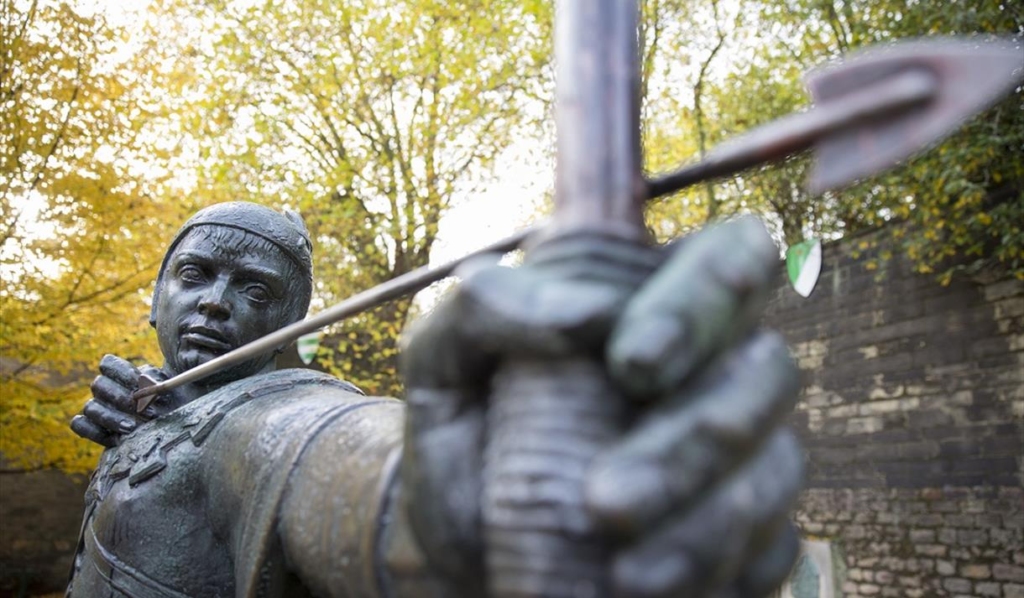ROBIN HOOD

Who is the High Sheriff of Nottingham really worried by?
One windy day on top of the motte of a Norman castle ruined the reputation of Robin Hood for me. And some better truths emerged from the uncertain mists of history. As a result, a legend was exposed for what it is.
After hearing a radio broadcast concerning the estate of Laxton, in Nottinghamshire, we found that it was the last remaining example of a Saxon strip farm left in England. So we went to view it and heard a presentation by the Bailiff. It was incredible to discover that the estate was managed by him in a Bailiff’s court in the manner of old.
After the presentation we went off to a high point to view the landscape. The Bailiff did not mention the castle but we were soon on top of the motte surveying the area. Interestingly, it sits on the west side of the River Trent and the major arterial, Great North Road, otherwise known poetically as the, A1 (M). From the height my attention was soon drawn to a view of three towers on the horizon.
“What’s that?” I asked.
“Lincoln Cathedral,” was the answer.
Thus came the end of my interest in a Saxon strip farm and the beginning of the search for the History of Laxton castle. The result of this led me to write the new novels of: ‘The Wars of the Magna Carta’.
Forming a legend
Within this story we find King John, formerly prince, who only became king after his brother Richard died. After much researching, a tale gradually emerged of female heroism and a hidden history. Of that you may read in the ‘The Wars of the Magna Carta’ books, but of Robin Hood, the Sheriff of Nottingham, and the forests of Sherwood?
In a world where stories tended to be passed on by Bards and Ballards, the truth often becomes left behind until it is secondary to a good story. This is not surprising when the tale could earn a meal from the telling whilst sat around a blazing log fire.
Thus do we form legends, until they take themselves into print. As you can see, we fashion a new truth from the imaginings of the firelight’s flickerings.
So we come to Robin Hood
The name in various forms appears in writings of the thirteenth century, most notably in an allegorical fantasy with the title: ‘Piers the Plowman’. Other later documents mention undesirables in the woods but this does not mean the Merry Men, it means those, ‘Outside the Laws,’ of the forest.
As time passes, Robin Hood begins to make more frequent appearances in literature, gathering characteristics as he goes, until he becomes ‘truth’ itself. Then in the nineteenth century, Sir Walter Scott, no less, gives him a new impetus in his novel ‘Ivanhoe’ (1820). As a result, the modern hero is set into history as fact.
But here is a problem; to research the history of Laxton is to research the history of Lincoln and Nottinghamshire. This includes the history of the forests, and of all the documents dissected, the chronicles, the pipe rolls, and various other contemporary sources of official records. In none of these are there mentions of the character of Robin, or Locksley, so richly drawn in legendary history.
There must be a history, but it is one of truth, of the times, of King John, of the Forests and the High Sheriff of Nottingham, and of the keepers of the King’s Forests, of two valorous women, of Nicholaa of Lincoln and Matilda of Laxton, female castellans, female Keepers, and one female Sheriff of Lincoln town.
The Sheriff of Nottingham
What of Robin’s adversary, the High Sheriff of Nottingham? His name was Philip Marc and he was only responsible for the royal hunting enclosure within the bounds of Sherwood. He made a mess of that small duty. In the 1215 Magna Carta – article (50) this appears:
“We will remove completely from their offices the kinsmen of Gerard de Athée, and in future they shall hold no offices in England. The people in question are: Engelard de Cigogné, Peter, Guy, and Andrew de Chanceaux, Guy de Cigogné, Geoffrey de Martigny and his brothers, Philip Marc and his brothers, with Geoffrey his nephew, and all their followers.”
It seems that Philip had been doing some tax collecting of his own. As a result he was interfering with the management of the forest by its rightful keeper, Matilda of Laxton.
So stand aside Robin Hood; Hollywood might love you, but history knows you for what you are, a figment of many imaginings. The real hero who fought against the Sheriff of Nottingham was Matilda of Laxton. You can read more of her and the heroine of Lincoln, kindred spirits, in the stories of: ‘The Wars of the Magna Carta’.
Available from Amazon in paperback and also on Kindle.

